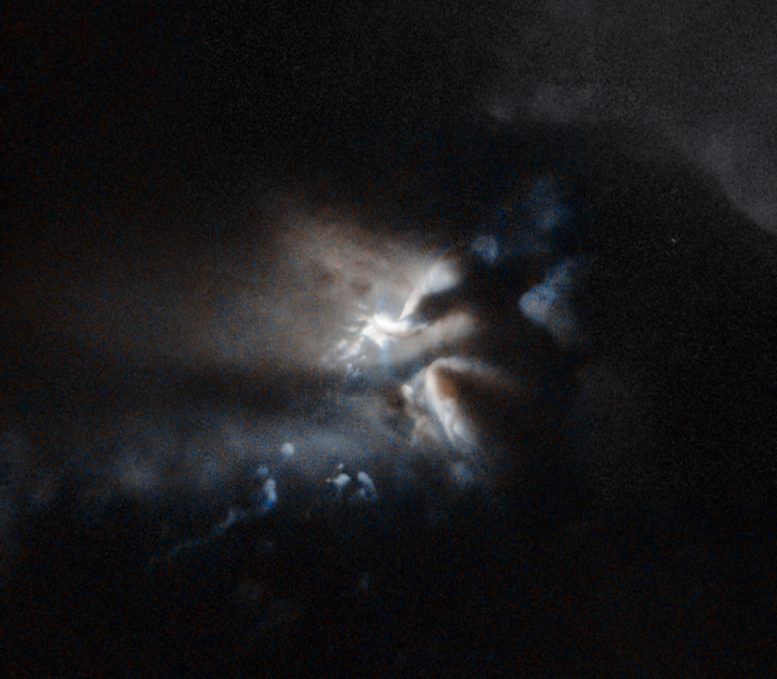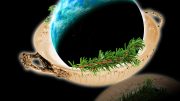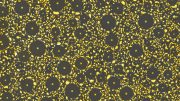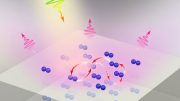
A young star is forming in the dark cloud LDN 43, located 520 light-years away in the Ophiuchus constellation. Credit: ESA/Hubble & NASA, Acknowledgement: Judy Schmidt
In this newly released image Hubble views a young star being born in the gas, dust, and ices of the dark cloud LDN 43.
Don’t be fooled by the title; the mysterious, almost mystical bright light emerging from these thick, ominous clouds is actually a telltale sign of star formation. Here, a very young star is being born in the guts of the dark cloud LDN 43 — a massive blob of gas, dust, and ices, gathered 520 light-years from Earth in the constellation of Ophiuchus (The Serpent Bearer).
Stars are born from cosmic dust and gas, which float freely in space until gravity forces them to bind together. The hidden newborn star in this image, revealed only by light reflected onto the plumes of the dark cloud, is named RNO 91. It is what astronomers call a pre-main sequence star, meaning that it has not yet started burning hydrogen in its core.
The energy that allows RNO 91 to shine comes from gravitational contraction. The star is being compressed by its own weight until, at some point, a critical mass will be reached and hydrogen, its main component, will begin to fuse together, releasing huge amounts of energy in the process. This will mark the beginning of adulthood for the star. But even before this happens the adolescent star is bright enough to shine and generate powerful stellar winds, emitting intense X-ray and radio emission.
RNO 91 is a variable star around half the mass of the Sun. Astronomers have been able to observe the existence of a dusty, icy disc surrounding it, stretching out to over 1700 times the distance from Earth to the Sun. It is believed that this disc may host protoplanets — planets in the process of being formed — and will eventually evolve into a fully-fledged planetary system.
This image is based on data gathered by the NASA/ESA Hubble Space Telescope. A version of this image was entered into the Hubble’s Hidden Treasures image processing competition by contestant Judy Schmidt.









It is my view that there is a great deal of assumption going on within the format of the comments being made regarding this image.
In the first instance, I cannot determine any indication of a ‘Star’ forming in the background.
There is obviously light being emitted which indicates that a body is present in the background vicinity however, there are none of the signs that ‘Collapse’ is actually manifesting.
The star, or whatever it is producing the light could just as easily be drifting along within Space/Time and simply passing a cloud of gas and dust as it does so.
I agree Peter. According to ‘science’, if the entire universe is less than 20 billion years old (as they claim), and there are thousands of trillions of stars in the sky, stars would have to be formed at the rate of more than one per second. We know this isnt the case, because NO star has been seen forming, EVER. And God said, “Let there be lights in the vault of the sky to separate the day from the night, and let them serve as signs to mark sacred times, and days and years, 15 and let them be lights in the vault of the sky to give light on the earth.” And it was so. 16 God made two great lights—the greater light to govern the day and the lesser light to govern the night. He also made the stars. Genesis chapter 1, verses 14-16. Day 4 of cf Creation.
To say or even believe that dust, ice particles move freely through space then all the sudden miraculously hit a batch of Gravity and are pulled in to form a star or planet is quite a ludicrous theory. Yes we know there are many stars, planets and unformed particles illuminating light and we also know that time and space theories are many; some make sense like earths 24hr cycle and that time appears to move faster the farther it is from the earths surface; and even that’s a bit questionable. man will always try to seek out answers for time and space, how things are created and from this need wonderous things are built, wonderous breakthroughs are found. But when it comes to how old our earth and planets and stars or the universe is? your all learning one common proof in the end of it all ” THAT WE REALLY DONT KNOW”